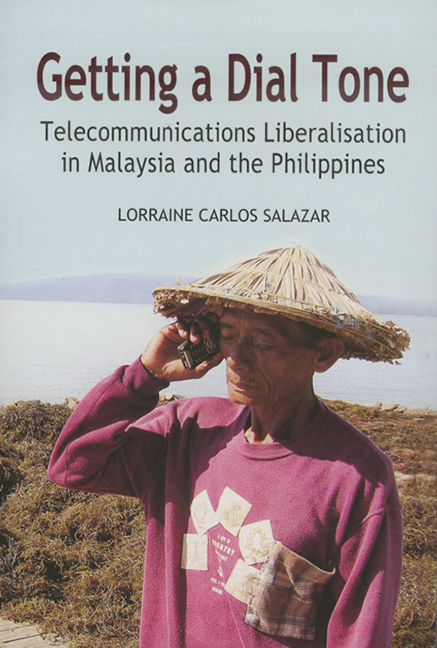Book contents
- Frontmatter
- Dedication
- Contents
- Map of Malaysia and the Philippines
- List of Tables
- List of Figures
- List of Appendices
- List of Abbreviations
- Acknowledgements
- 1 Rent-Seeking, Market Reforms, and States
- 2 Reviewing the Literature: Theories and Puzzles
- 3 Historical Overview of the State and Business in Malaysia and the Philippines
- 4 The Telecommunications Sector in Malaysia and the Philippines Before Reform
- 5 Reforming the Malaysian Telecommunications Sector
- 6 The Liberalisation of Telecommunications in Malaysia
- 7 Regulatory Reforms in Malaysia
- 8 Reforming the Telecommunications Sector of the Philippines
- 9 The New Players and the Service Area Scheme
- 10 Regulatory Reforms in the Philippines
- 11 Conclusions
- Appendices
- Bibliography
- Index
- About the Author
4 - The Telecommunications Sector in Malaysia and the Philippines Before Reform
Published online by Cambridge University Press: 21 October 2015
- Frontmatter
- Dedication
- Contents
- Map of Malaysia and the Philippines
- List of Tables
- List of Figures
- List of Appendices
- List of Abbreviations
- Acknowledgements
- 1 Rent-Seeking, Market Reforms, and States
- 2 Reviewing the Literature: Theories and Puzzles
- 3 Historical Overview of the State and Business in Malaysia and the Philippines
- 4 The Telecommunications Sector in Malaysia and the Philippines Before Reform
- 5 Reforming the Malaysian Telecommunications Sector
- 6 The Liberalisation of Telecommunications in Malaysia
- 7 Regulatory Reforms in Malaysia
- 8 Reforming the Telecommunications Sector of the Philippines
- 9 The New Players and the Service Area Scheme
- 10 Regulatory Reforms in the Philippines
- 11 Conclusions
- Appendices
- Bibliography
- Index
- About the Author
Summary
This chapter describes the condition of the telecommunications industry in Malaysia and the Philippines before market reform by examining the condition of the telecommunications sector and the roles played by the state and private actors. The patterns of political patronage, the types of rents, the way they were obtained, who acquired them, and how they were used will also be analysed. Finally, the question why the Malaysian telecommunications sector was more efficient than that of the Philippines will be addressed.
Immediately after independence, Malaysia was left with a fairly efficient communications infrastructure. Telecommunications were originally the responsibility of a state department that had monopoly control of service delivery. The private sector's role was limited to equipment supply. With the introduction of the New Economic Policy (NEP), the state's monopoly over the telecommunications sector was used to allocate patronage to Malays through the award of licenses for some services and equipment supply contracts. The NEP goal of rapid economic development led to massive state investment for the expansion of the communications sector in the 1980s. The modernisation of the communications infrastructure, however, was also used to create business opportunities for Malays. State patronage of these businessmen resulted in increased costs and inefficiencies in the infrastructure expansion programme. Yet, the economic impact was generally expansionary and growth-enhancing.
Under American occupation, foreign-owned companies under state regulation provided telecommunications services in the Philippines. In 1967, a group of Filipino businessmen close to then President Ferdinand Marcos took over ownership of the Philippine Long Distance Telephone Company (PLDT). PLDT had sole authority to operate a national communications network. During the 1970s, PLDT consolidated its monopoly status, and was under very little state pressure to expand its network and improve its services. A few other businessmen were granted exclusive privileges by the Marcos regime to operate various communications services, and small provincial telephone companies proliferated due to unmet demand. Yet, the state protected the monopoly profit of PLDT, whose services were inefficient. Monopoly rent was captured for private profit, and was growth-hindering.
- Type
- Chapter
- Information
- Getting a Dial ToneTelecommunications Liberalisation in Malaysia and the Philippines, pp. 86 - 132Publisher: ISEAS–Yusof Ishak InstitutePrint publication year: 2007

